Biała Góra (mountain)
| Biała Góra | ||
|---|---|---|
|
View from the Sanok market place on the mountains |
||
| height | 529 m | |
| location | Poland | |
| Mountains | Forest Carpathians | |
| Coordinates | 49 ° 33 '0 " N , 22 ° 13' 0" E | |
|
|
||
Biała Góra (German Weißenberg ) is a 529 m npm high mountain near Sanok in the southern part of the Saana Mountains or Słonne Mountains (or Salt Mountains of Sanok) - Mountains between Sanok, Turka and Stryj , in the extreme southeast of the country in the powiat Sanocki of the voivodeship Subcarpathian , in southeastern Poland .
The peak of the Biała Góra dominates the valley of the San River , on the border between the Beskydy and the Forest Carpathians . The highest point of the mountain is called Zamczysko or ugly castle . On its summit, which can be reached on hiking trails, is the place with relics of the early medieval hill fort . On the hill between Biała-Góra and Kopacz was already in Celtic times with the location of the Celtic settlement findings.
The largest museum of folk architecture in the country is located on the southeast slope . A large King's Fountain was later installed on the north side of Białogórska Street.
Dense oak and hornbeam forests grow in the central part of the hill .
See also
Web links
Footnotes
- ^ Josef von Reilly : The Kingdom of Galicia and Lodomeria middle circles. No. 36. Vienna. 1791 .; "The Saan, which rises in the Sanok district, on the Saana mountains, from which the Sanok excludes the Osława river ," In: Johann Andreas Demian: Representation of the Austrian monarchy according to the latest statistical relationships. 1804. p. 12.
- ↑ "Biała Góra, pow. Sanok. Szczyt góry zwany Zamczysko leży w łańcuchu Słonne Góry nad rzeką San" in: Światowid. t. 23, 1955
- ^ Władysław Kowalenko: Lexicon antiquitatum slavicarum. PAN
- ↑ "1549 król Zygmunt August potwierdza mieszczanom wolnego użytku pastwisk na górze betw. Biała Góra i na polu alias na błonie za Sanem, ..." In: Adam Carnival: Słownik historyczno-geograficzny ziemi sanockniowie w średniowiej w średniowiej P. 41

